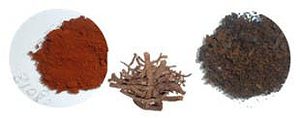
Purpurin, left, extracted from madder root, center, is chemically lithiated, right, for use as an organic cathode in batteries. (c) Ajayan Group/Rice University
Researchers at Rice University and City College of New York have devised rechargeable lithium-ion batteries using a substance extracted from the madder plant as a cathode. The plant has been used since ancient times as a dye, and only recently have researchers learned about its fantastic capabilities it poses as an alternative green battery.
The madder plant or Rubia tinctorum is a potent source of purpurin, an organic dye that also works as a reliable cathode for lithium-ion batteries. The organic compound’s alternative use as a prime ingredient for green batteries was found after the researchers extensively searched for organic molecules for their ability to electrochemically interact with lithium and found purpurin most amenable to binding lithium ions.
Currently most of the world’s lithium-ion batteries, used to charge just about any mobile device from your smartphone to an electric car, employ cobalt as the cathode, which is a toxic element in excess. Currently 30% of the world’s production of cobalt is directed to lithium-ion production and is extremely expensive to extract and chemically manufacture it into a cathode since it requires a high temperature environment, at a huge energy expense. This is why they’re also very expensive to recycle. In 2010 alone, almost 10 billion lithium-ion batteries had to be recycled, which uses a lot of energy. Furthermore 72 kilograms of carbon dioxide are pumped into the atmosphere for every kilowatt-hour of energy in a lithium-ion battery.
“Green batteries are the need of the hour, yet this topic hasn’t really been addressed properly,” said lead author Arava Leela Mohana Reddy. “This is an area that needs immediate attention and sustained thrust, but you cannot discover sustainable technology overnight. The current focus of the research community is still on conventional batteries, meeting challenges like improving capacity. While those issues are important, so are issues like sustainability and recyclability.”
Less expensive, easier-to-recycle alternative to cobalt oxide cathode
The researchers added 20 percent carbon to purpurin for conductivity half-battery cell with a capacity of 90 milliamp hours per gram after 50 charge/discharge cycles. The whole process was undertaken at room temperature, so the high energy consumption need to heat cobalt is now saved.
[RELATED] World’s smallest battery
It’s a new mechanism we are proposing with this paper, and the chemistry is really simple,” Reddy said.
Purpurin doesn’t necessary have to come solely from madder, however. Agricultural waste may be a source of purpurin, as may other suitable molecules, which makes the process even more economical, though some of you might have found the prospect of growing millions of climbing plants amusing. The idea isn’t half bad, though, as millions of madder plants would soak up important amounts of carbon from the atmosphere.
We’re interested in developing value-added chemicals, products and materials from renewable feedstocks as a sustainable technology platform,” said co-lead author George John, a professor of chemistry at the City College of New York-CUNY and an expert on bio-based materials and green chemistry. “The point has been to understand the chemistry between lithium ions and the organic molecules. Now that we have that proper understanding, we can tap other molecules and improve capacity.”
For the anode, the other electrode in a lithium-ion battery, the same team of scientists experienced interesting results with a combination of silicon and a porous nickel current collector. The next obvious step towards building a completely green battery is to find a suitable organic molecule for the anode. “What we’ve come up with should lead to much more discussion in the scientific community about green batteries,” Reddy said.
The findings were reported in Nature’s online, open-access journal Scientific Reports.
source: Rice University









